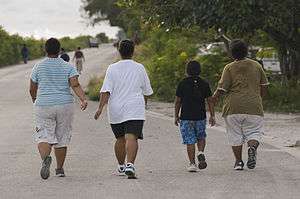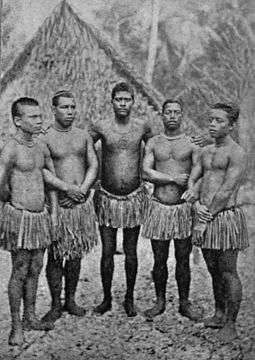Obesity in the Pacific
Pacific island nations and associated states make up the top seven on a 2007 list of heaviest countries, and eight of the top ten. In all these cases, more than 70% of citizens age 15 and over are obese.[1] A mitigating argument is that the BMI measures used to appraise obesity in Caucasian bodies may need to be adjusted for appraising obesity in Polynesian bodies, which typically have larger bone and muscle mass than Caucasian bodies; however, this would not account for the drastically higher rates of cardiovascular disease and diabetes among these same islanders.[2][3][4][5]


Obesity in Pacific islands is a growing health concern with health officials stating that it is one of the leading causes of preventable deaths in the Pacific Rim.
Overweight populations
| World ranking[1] | Pacific country | % of overweight persons (age 15 and over) |
|---|---|---|
| 1. | Nauru | 94.5 |
| 2. | Micronesia, Federated States of | 91.1 |
| 3. | Cook Islands | 90.9 |
| 4. | Tonga | 90.8 |
| 5. | Niue | 81.7 |
| 6. | Fiji | 80.4 |
| 7. | Palau | 78.4 |
| 10. | Kiribati | 73.6 |
Obese populations[6]
| Rank | Country | % of obese persons |
|---|---|---|
| 1 | Nauru | 61.00 |
| 2 | Cook Islands | 55.90 |
| 3 | Palau | 55.30 |
| 4 | Marshall Islands | 52.90 |
| 5 | Tuvalu | 51.60 |
| 6 | Niue | 50.00 |
| 7 | Tonga | 48.20 |
| 8 | Samoa | 47.30 |
| 9 | Kiribati | 46.00 |
| 10 | Federated States of Micronesia | 45.80 |
Nations
Nauru
Obesity is seen as a sign of wealth in Nauru.[7] 31% of Nauruans are diabetic.[8] This rate is as high as 45% among the 55–64-year-old age group .[7]
Tonga
Life expectancy has fallen to 64 in Tonga. Tongan life expectancy used to be in the mid-70s.[9] Up to 40% of the population is said to have type 2 diabetes.[9] Tongan Royal Tāufaʻāhau Tupou IV, who died in 2006, holds the Guinness World Record for being the heaviest-ever monarch— with a weight of 200 kilograms (440 lb).[9]
Fiji
In Fiji, strokes used to be rare in people under 70. Now, doctors report that they have become common amongst patients in their 20s and 30s.[10] Research done on globalization's impact on health indicates that the rise in average BMI in Fiji correlates with the increase in imports of processed food.[11] Dr Temo K Waqanivalu, a Fijian representative for WHO, attributes health problems in his country to the replacement of traditional foods by more glamorous imported foods.[12]
Marshall Islands
In the Marshall Islands in 2008, there were 2000 cases of diabetes out of a population of 53,000.[10] A survey done in the Marshall Islands revealed that the percentage of the total population considered overweight or obese was 62.5%.[13]
Causes
Much of the local diet is of processed, salt and calorie-dense, imported food such as spam or corned beef, rather than fresh fish, fruit and vegetables, in part because past mining reduced the amount of arable land.[14][15][16] Some high-saturated-fat foods such as mutton flaps and turkey tails are sold in the Pacific islands due to relatively low wealth.[17] A relatively sedentary lifestyle, including among children, is also contributing to rising obesity rates.[18]
Obesity in the Pacific Islands is also thought to be influenced by cultural factors (tambu foods), including past poor public education on diet, exercise and health[19] (micronutrient deficiencies are also common[20]). Feasting and festivals continue currently to be major parts of life,[21] imported foods have been given higher social status than local, healthier foods,[19] and historically a large body size was associated with wealth, power and beauty.[7][19]
High rates of obesity appear within 15 months of birth.[22]
Results
Obesity is leading to increased levels of illness, including diabetes[23] and heart diseases.
See also
- List of countries by Body Mass Index (BMI)
- Genetics of obesity
- New World Syndrome
- Epidemiology of obesity
References
- Lauren Streib (8 February 2007). "World's Fattest Countries". Forbes. Archived from the original on 25 January 2017.
- https://www.researchgate.net/publication/304572609_Polynesian_Bones
- "Fat of the land: Nauru tops obesity league". 26 December 2010.
- https://www.wsj.com/articles/SB10001424127887324695104578417043182612254%5B%5D
- Snowdon, Wendy; Malakellis, Mary; Millar, Lynne; Swinburn, Boyd (2014). "Ability of body mass index and waist circumference to identify risk factors for non-communicable disease in the Pacific Islands". Obesity Research & Clinical Practice. 8 (1): e36–45. doi:10.1016/j.orcp.2012.06.005. PMID 24548575.
- https://www.cia.gov/library/publications/the-world-factbook/fields/367rank.html
- Marks, Kathy (26 December 2010). "Fat of the land: Nauru tops obesity league". The Independent. Retrieved 23 January 2013.
- Streib, Lauren (2 August 2007). "Nauru: 94.5% overweight". Forbes.com. Retrieved 23 January 2013.
- "How mutton flaps are killing Tonga". BBC News. 18 January 2016. Retrieved 19 January 2016.
- "Modern life means modern ills for obese Pacific islanders". AFP. 8 February 2008. Retrieved 21 August 2009.
- "The effect of sugar and processed food imports on the prevalence of overweight and obesity in 172 countries". 14 April 2018. doi:10.1186/s12992-018-0344-y.
- "WHO | Pacific islanders pay heavy price for abandoning traditional diet". www.who.int. Retrieved 4 November 2018.
- Ichiho, Henry M.; Seremai, Johannes; Trinidad, Richard; Paul, Irene; Langidrik, Justina; Aitaoto, Nia (May 2013). "An assessment of non-communicable diseases, diabetes, and related risk factors in the Republic of the Marshall Islands, Kwajelein Atoll, Ebeye Island: a systems perspective". Hawai'i Journal of Medicine & Public Health: A Journal of Asia Pacific Medicine & Public Health. 72 (5 Suppl 1): 77–86. ISSN 2165-8242. PMC 3689463. PMID 23901366.
- Nick Squires (12 April 2008). "Spam at heart of South Pacific obesity crisis". The Daily Telegraph. London. Retrieved 21 August 2009.
- Phil Mercer (26 February 2007). "South Pacific Leads the World in Obesity". Archived from the original on 24 June 2016. Retrieved 15 July 2016.
- Obesity in Nauru#Cause of obesity
- https://www.bbc.co.uk/news/magazine-35346493
- "Pacific Islanders are world's fattest". BBC News. 28 November 2001. Retrieved 21 August 2009.
- http://www.wpro.who.int/publications/docs/obesityinthepacific.pdf?ua=1
- http://www.who.int/bulletin/volumes/88/7/10-010710/en/
- http://news.bbc.co.uk/1/hi/world/asia-pacific/1681297.stm
- https://news.brown.edu/articles/2013/02/obesity
- Colagiuri, S; Colagiuri, R; Na'Ati, S; Muimuiheata, S; Hussain, Z; Palu, T (2002). "The Prevalence of Diabetes in the Kingdom of Tonga". Diabetes Care. 25 (8): 1378–83. doi:10.2337/diacare.25.8.1378. PMID 12145238.
.svg.png)